Overview
A deep, positively tilted upper trough was positioned from south-central Canada to the eastern Rockies on the morning of October 30th. The trough moved northeastward into the Upper Midwest by the morning of the 31st (and started to become neutral, then negatively tilted). At the same time, surface low pressure in the Southern Plains was rapidly deepening as it tracked into the Ohio Valley. A trailing cold front was positioned from KY to the north-central Gulf of America during the morning of the 31st. Ahead of the front, temperatures (and dew points) were already in the 60s across our CWA, with 70 degree dew points in the Carolinas. The airmass behind the cold front was anomalously cold for the end of October (several inches of snow fell over parts of the Midwest). A line of showers (with gusty winds) was located along the cold front. Rapid cyclogenesis continued as the low tracked northeastward toward New England. This allowed for the cold front to rapidly move to the east (reaching the mountains of VA by early evening on 10/31). Temperatures were in the mid 70s-low 80s across the area, with dew points around 70°. By this time, a line of thunderstorms had developed across the western Carolinas (in a warm, moisture rich airmass with moderate instability). These thunderstorms developed slightly ahead of the cold front/aforementioned line of showers.
By 7 PM on the evening of the 31st, the pre-frontal line of thunderstorms had tracked to the northeast, and was now positioned from the southern VA Piedmont (just W of our CWA) to the central Carolinas. With a strengthening low to our N and a strong cold front approaching from the W, it is not a surprise that the low-mid level kinematics were favorable for damaging winds and a few tornadoes. While surface winds were largely out of the south, a strong (50 kt) south-southwesterly 925 mb jet was positioned over our area. This resulted in 300-500 m2/s2 of 0-1 km SRH. Deep layer shear was present from the surface to the mid levels (500 mb winds were SW at 70-90 kt). Marginal-moderate instability (500-1500 J/kg of MLCAPE...highest south) was present over our CWA during the evening. As the line crossed our western CWA boundary (just before 8 PM), one of the cells produced an EF-1 tornado in the southwestern part of Mecklenburg County, VA. The pre-frontal line slowly weakened as it approached central VA (likely due to slowly waning instability) and had nearly fallen apart by 10 PM. Meanwhile, the actual cold front (and line of showers along it) was tracking eastward across the VA Piedmont by 10 PM. Widespread gusts of 35-45 mph were measured at AWOS sites across the VA Piedmont as the line tracked through. The line increased in intensity as it tracked through central VA, with gusts up to 50 mph measured (with a 51 mph gust at RIC). Additional strengthening occurred as the line tracked through the Lower MD Eastern Shore/eastern VA/NE NC, with some bowing segments noted. This may have been due to a strengthening south-southwesterly 925 mb jet (65-70 kt by midnight across coastal areas). In addition to widespread 50-60 mph (measured) wind gusts, a tornado (EF-1) briefly touched down in the southern part of the City of Chesapeake. A few gusts of 65-70 mph were measured at two near-surface marine sites (Dominion Terminal on the Lower James River and Ocean City).
The widespread wind resulted in areas of downed trees and power lines (especially across SE VA and the Lower MD Eastern Shore). In addition, there were a few reports of minor structural damage due to the intense straight line winds.
Tornadoes:
|
Tornado - Southwest Mecklenburg
Track Map 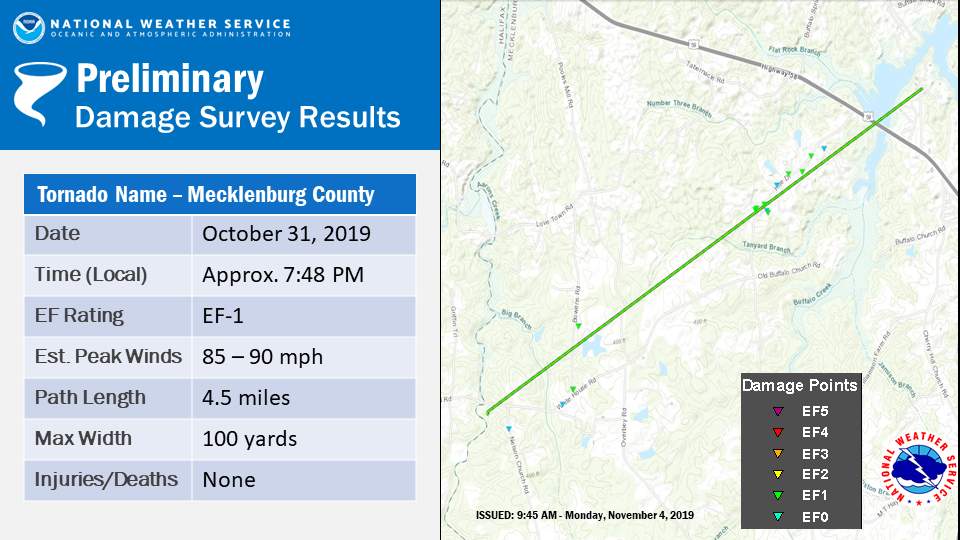 
Downloadable KMZ File |
||||||||||||||||
|
Tornado - Southern Chesapeake
Track Map 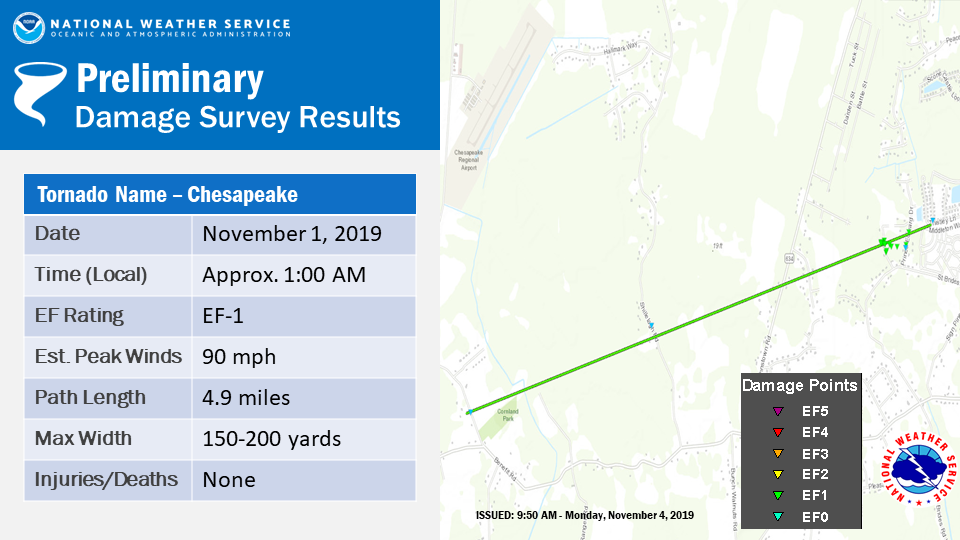 
Downloadable KMZ File |
||||||||||||||||
The Enhanced Fujita (EF) Scale classifies tornadoes into the following categories:
| EF0 Weak 65-85 mph |
EF1 Moderate 86-110 mph |
EF2 Significant 111-135 mph |
EF3 Severe 136-165 mph |
EF4 Extreme 166-200 mph |
EF5 Catastrophic 200+ mph |
 |
|||||
Photos
Chesapeake Tornado
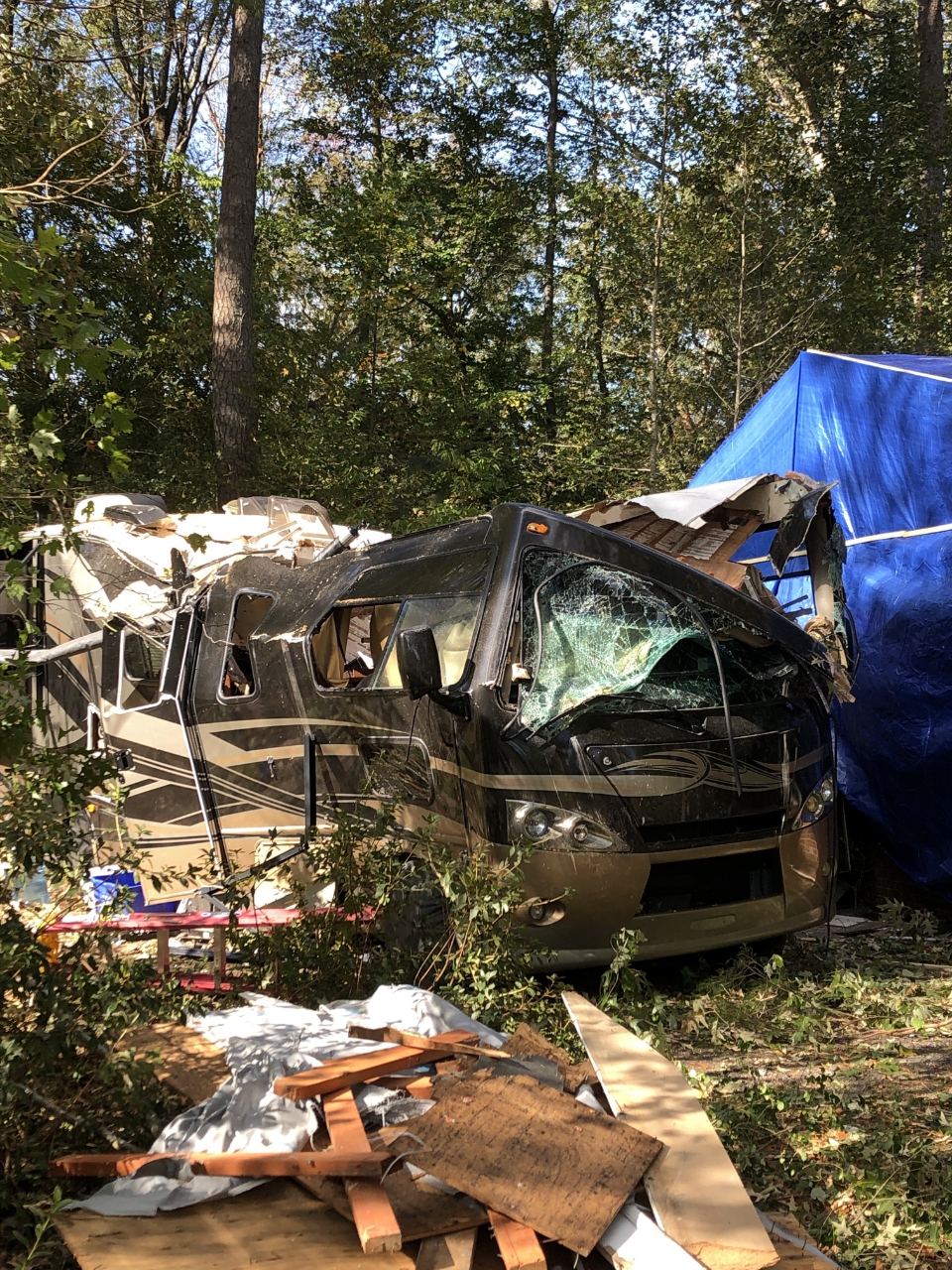 |
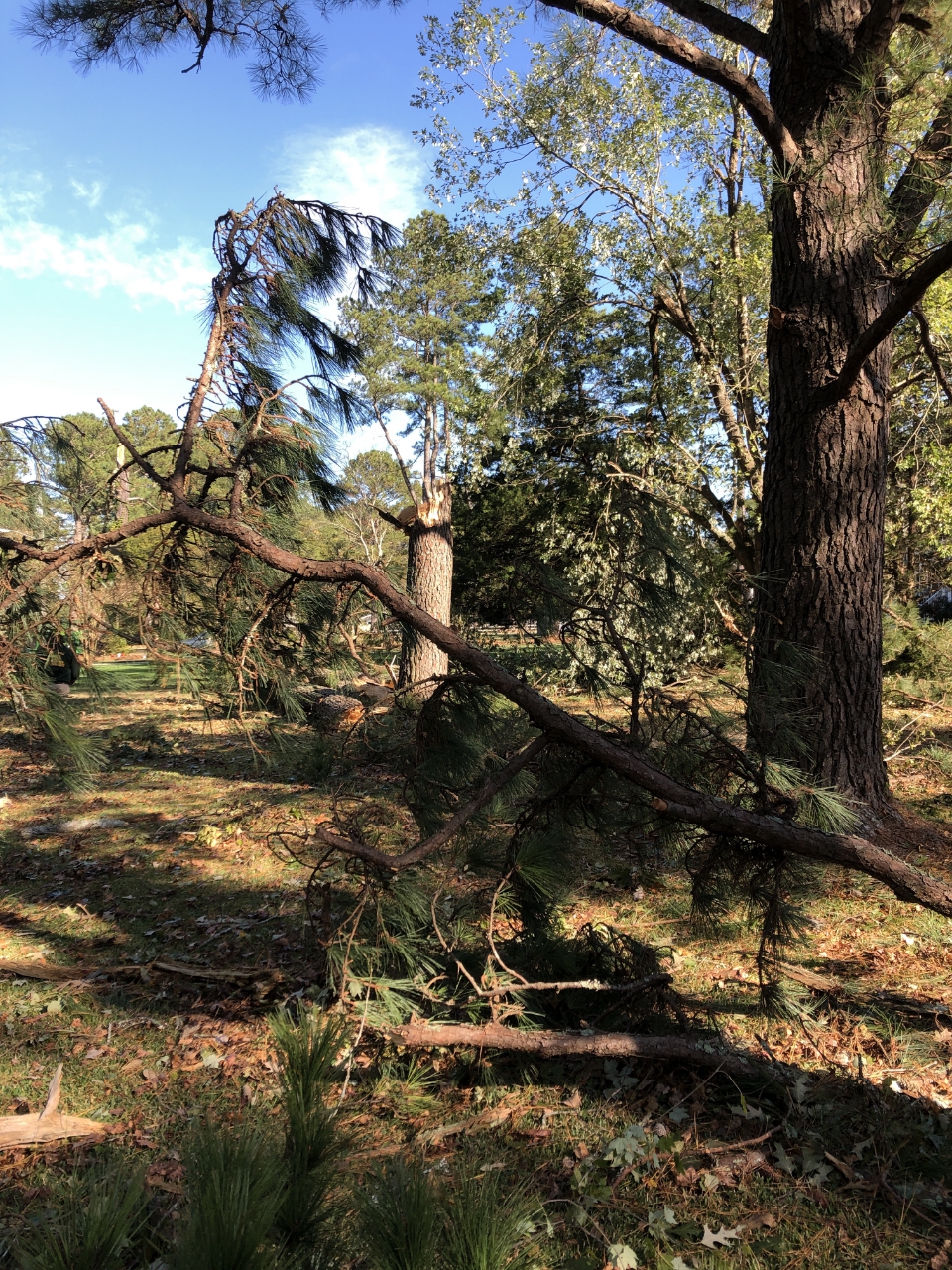 |
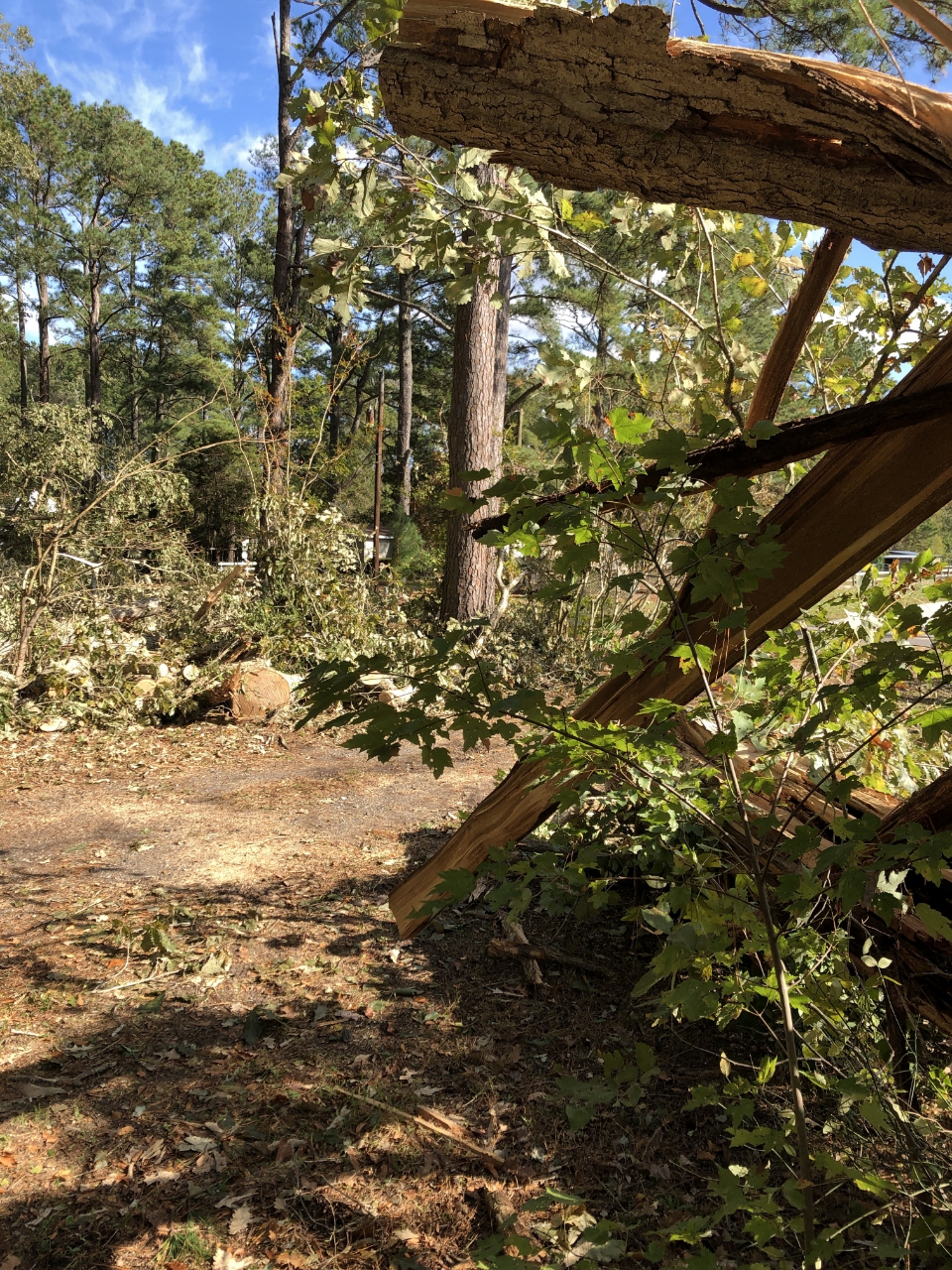 |
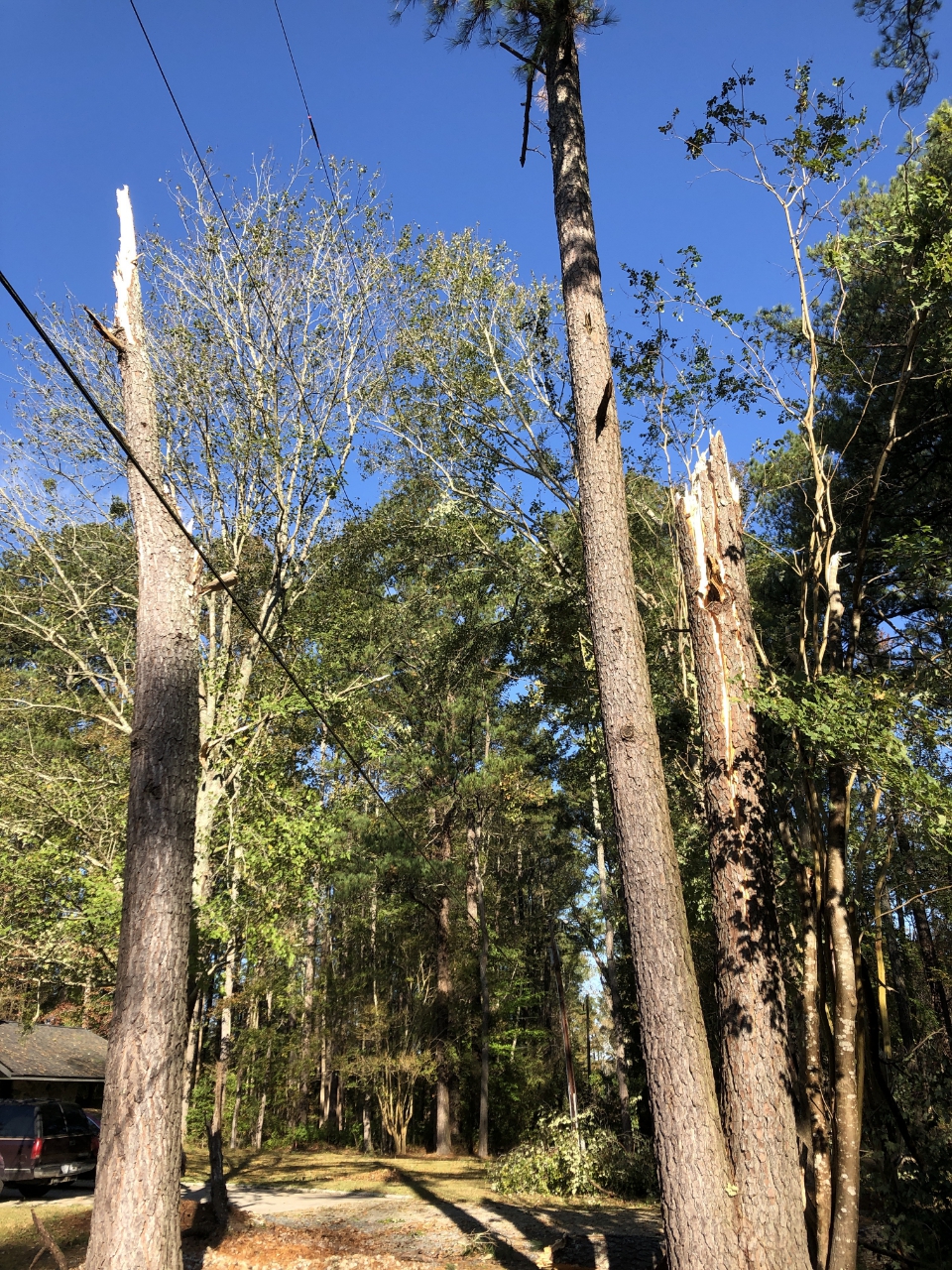 |
| Dewald Rd (NWS Survey) |
Dewald Rd (NWS Survey) |
Dewald Rd (NWS Survey) |
Shillelagh Rd (NWS Survey) |
Mecklenburg Tornado
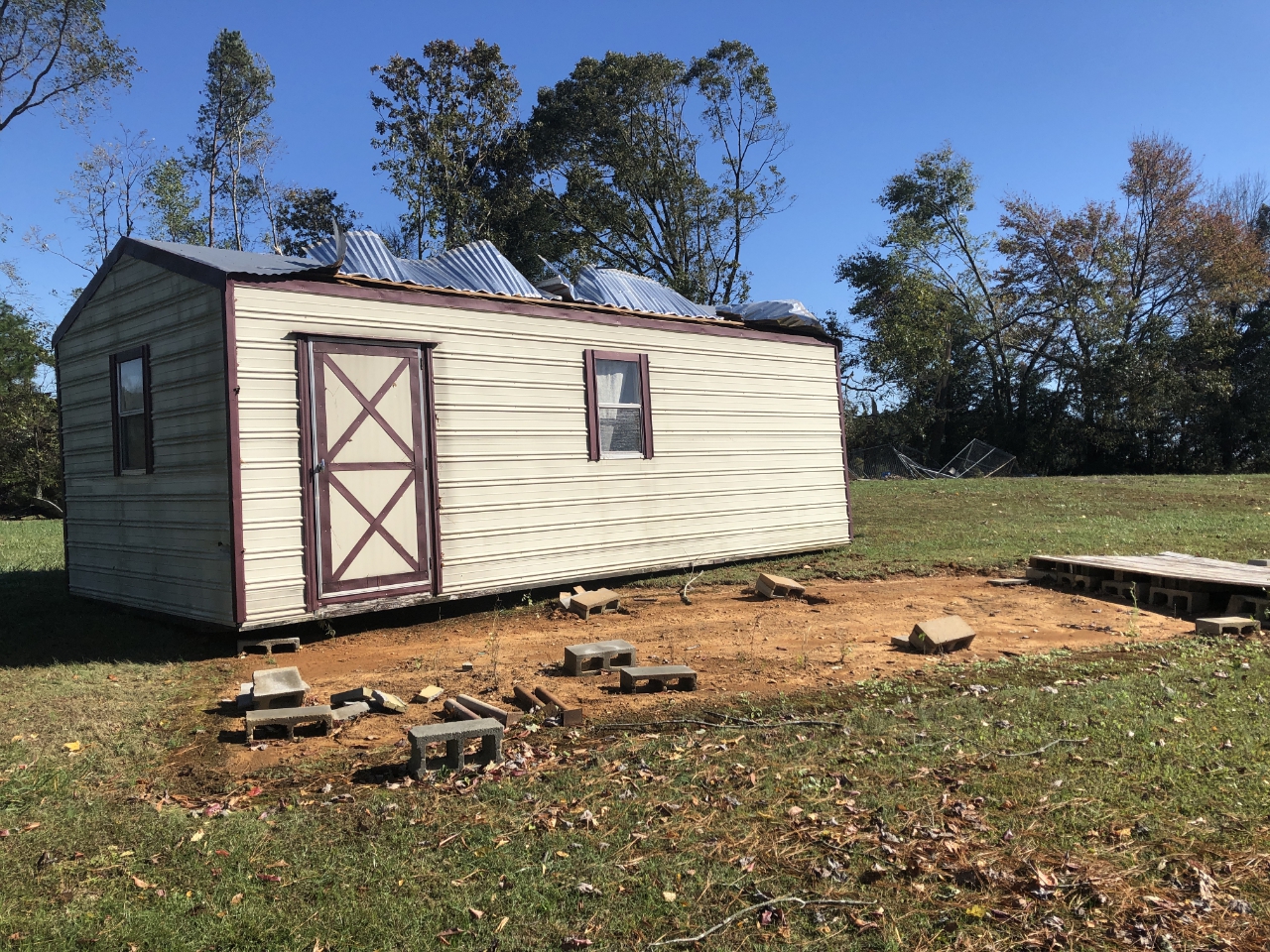 |
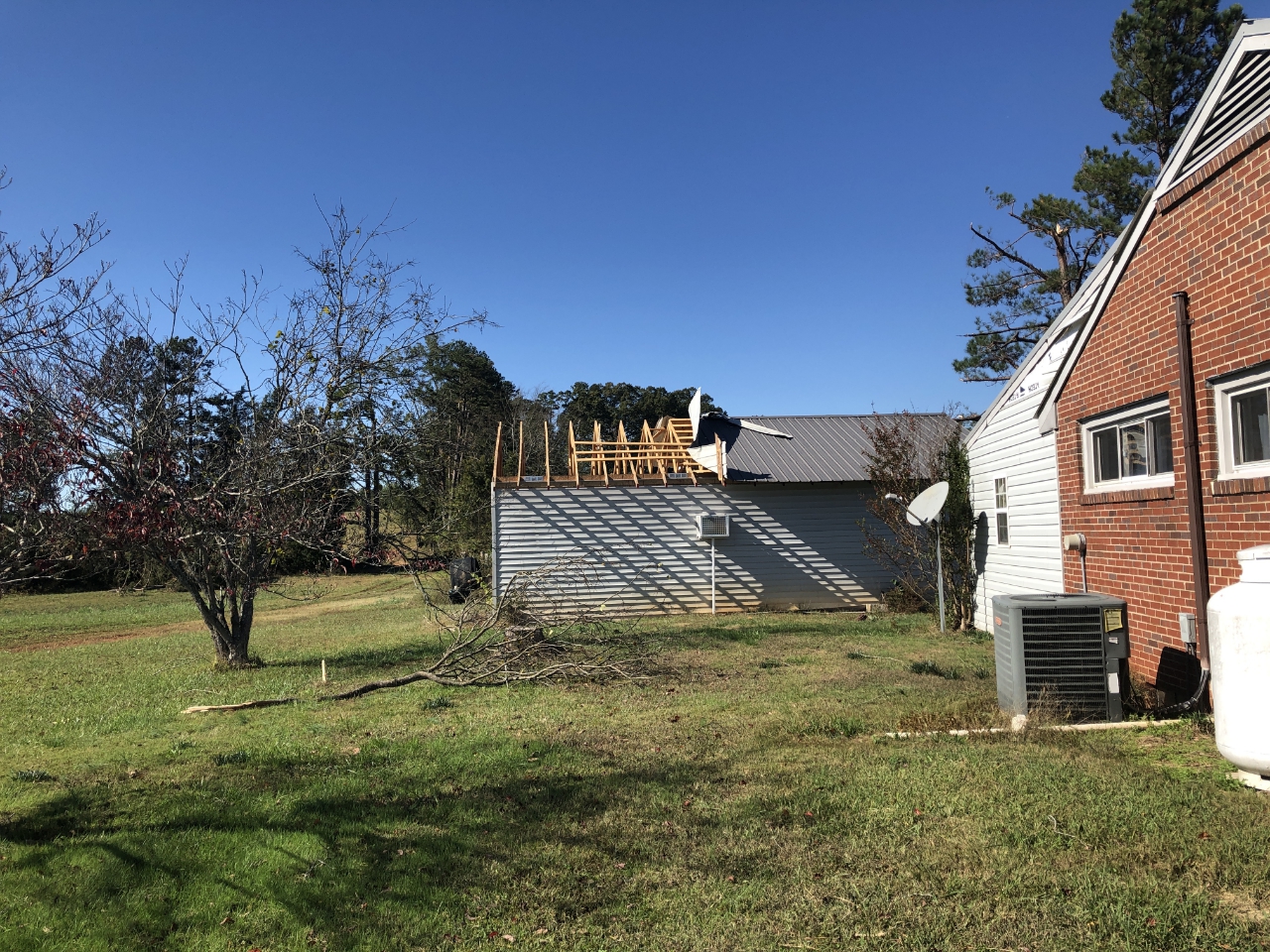 |
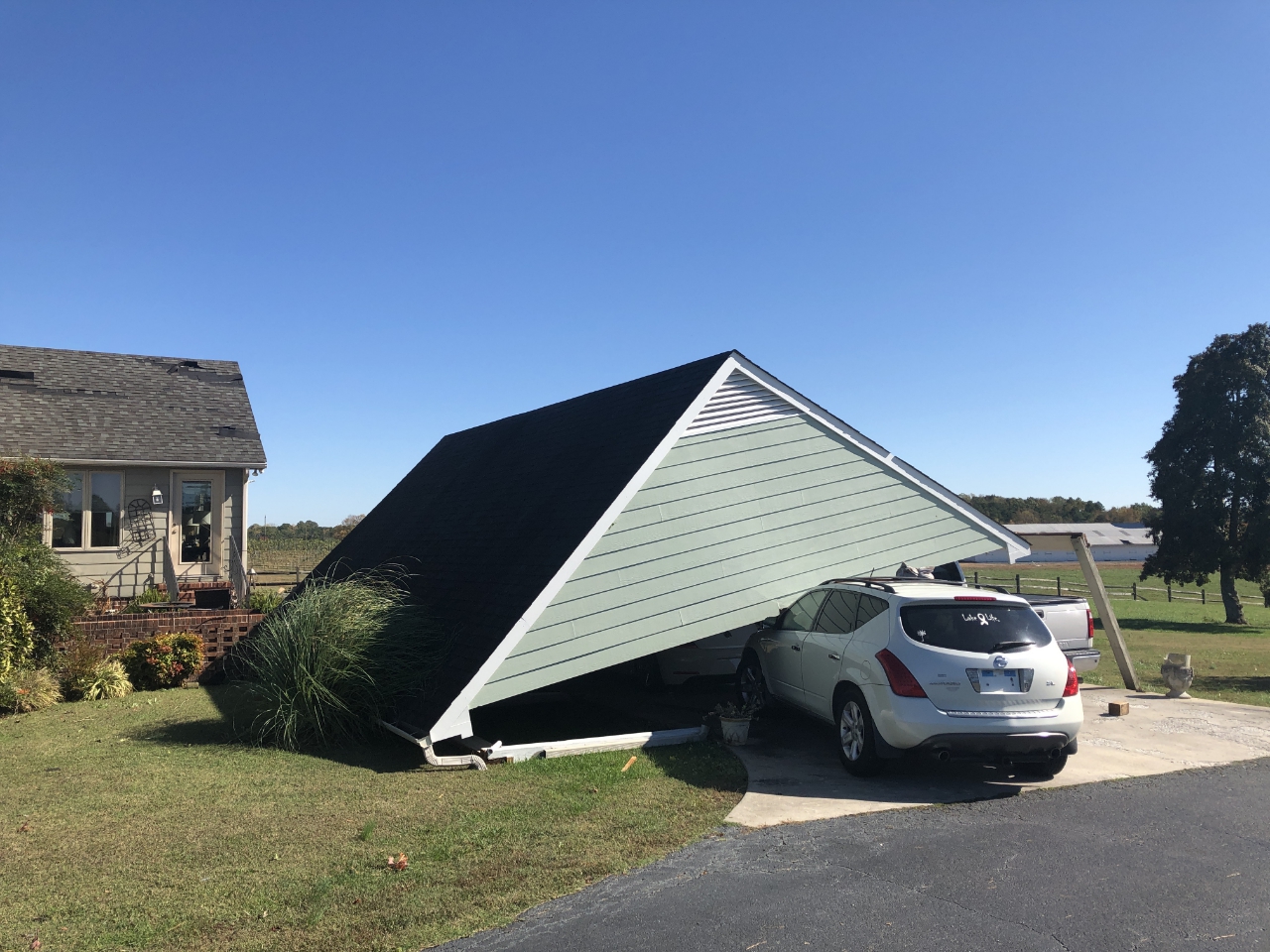 |
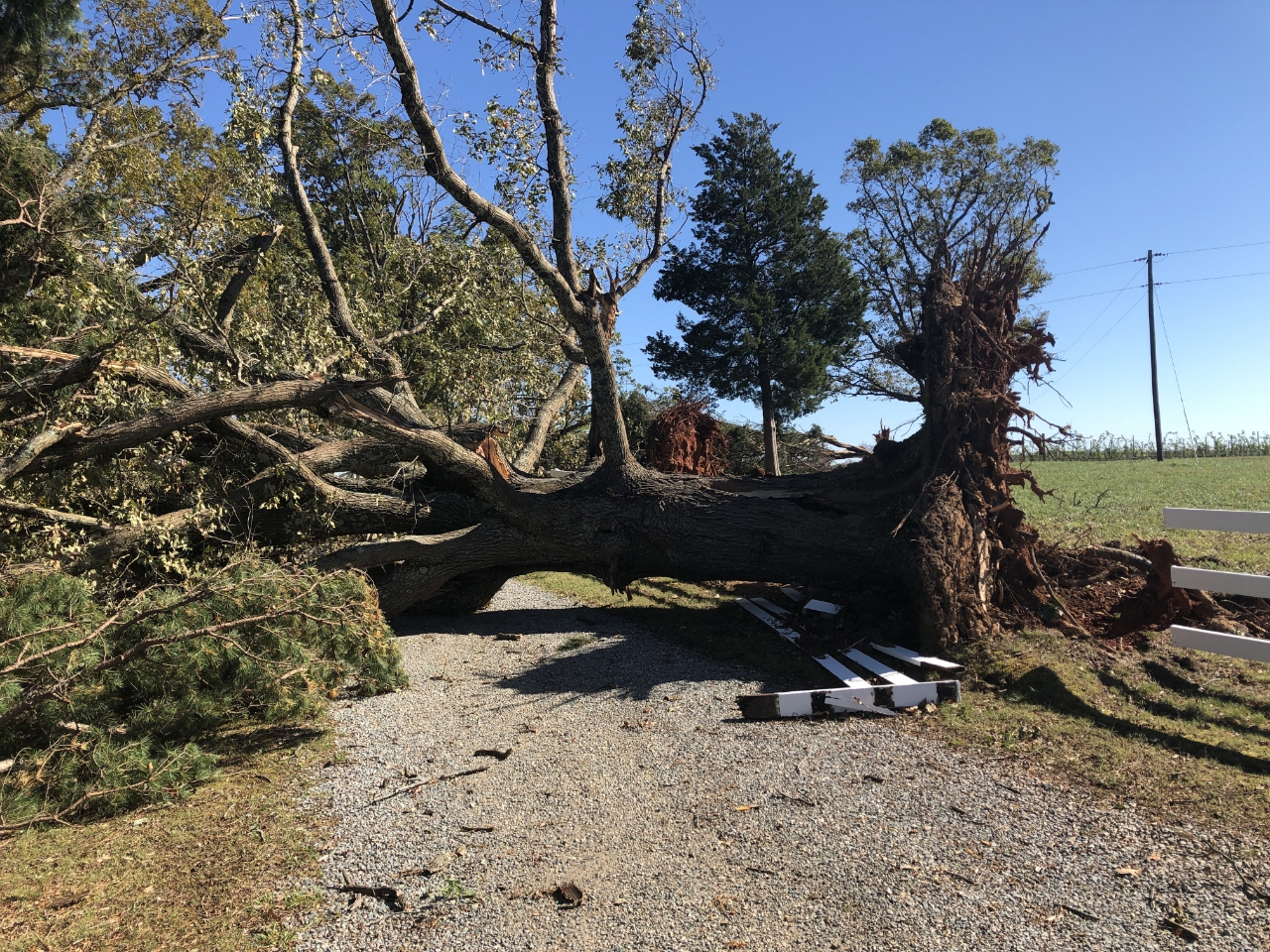 |
| Bowens Rd (NWS Survey) |
Hite Rd (NWS Survey) |
Hite Rd (NWS Survey) |
Hite Rd (NWS Survey) |
Radar
Animated Radar Images from the Two Tornadoes in the AKQ CWA
 |
 |
| Animated Radar Sequence of SW Mecklenburg Tornado from KRAX radar. Top Left: 0.2° Reflectivity. Top Right: 0.2° Base Velocity. Bottom Left: 0.2° Correlation Coefficient. | Animated Radar Sequence of Chesapeake Tornado from KAKQ radar. Top Left: 0.5° Reflectivity. Top Right: 0.5° Base Velocity. Bottom Left: 0.5° Correlation Coefficient. |
Additional Storm Reports
PRELIMINARY LOCAL STORM REPORT...SUMMARY NATIONAL WEATHER SERVICE WAKEFIELD VA 403 PM EDT FRI NOV 1 2019 ..TIME... ...EVENT... ...CITY LOCATION... ...LAT.LON... ..DATE... ....MAG.... ..COUNTY LOCATION..ST.. ...SOURCE.... ..REMARKS.. 1241 AM TSTM WND GST WARDS CORNER 36.92N 76.27W 11/01/2019 M59 MPH CITY OF NORFOLK VA AWOS AWOS STATION KNGU NORFOLK NAS CHAM. 1240 AM TSTM WND GST 3 SSE TANGIER 37.79N 75.97W 11/01/2019 M76 MPH ACCOMACK VA MESONET MESONET STATION XTSL TANGIER SOUND LIGHT. 0814 PM TSTM WND GST 3 ENE ROGERS CORNER 36.73N 78.36W 10/31/2019 M55 MPH MECKLENBURG VA TRAINED SPOTTER 0102 AM TSTM WND DMG ONLEY 37.69N 75.71W 11/01/2019 ACCOMACK VA 911 CALL CENTER TREE ON POWERLINES ON PENNSYLVANIA AVE. IN ONLEY. 0101 AM TSTM WND DMG WILLARDS 38.39N 75.35W 11/01/2019 WICOMICO MD 911 CALL CENTER TREES AND POWERLINES DOWN IN AROUND WILLARDS. 0101 AM TSTM WND DMG POWELLVILLE 38.33N 75.38W 11/01/2019 WICOMICO MD 911 CALL CENTER TREES AND POWERLINES DOWN AROUND POWELLVILLE. 0101 AM TSTM WND DMG 1 SSW BAY VIEW 37.27N 75.97W 11/01/2019 NORTHAMPTON VA 911 CALL CENTER LARGE TREE DOWN ON LANKFORD HWY. 1244 AM TSTM WND DMG 1 E FRUITLAND 38.32N 75.61W 11/01/2019 WICOMICO MD 911 CALL CENTER TRANSFORMER FIRE IN FRUITLAND. 1244 AM TSTM WND DMG SALISBURY 38.37N 75.59W 11/01/2019 WICOMICO MD 911 CALL CENTER TREES AND POWERLINES DOWN IN SALISBURY. 1235 AM TSTM WND DMG ALLEN 38.29N 75.69W 11/01/2019 WICOMICO MD 911 CALL CENTER POWERLINES DOWN ALONG ALLEN ROAD. 0914 PM TSTM WND DMG ALBERTA 36.86N 77.88W 10/31/2019 BRUNSWICK VA 911 CALL CENTER A FEW TREES AND POWERLINES DOWN IN BRUNSWICK COUNTY. 0845 PM TSTM WND DMG GOOCHLAND 37.68N 77.89W 10/31/2019 GOOCHLAND VA 911 CALL CENTER A FEW TREES DOWN THROUGHOUT GOOCHLAND COUNTY. 0845 PM TSTM WND DMG LOUISA 38.02N 78.00W 10/31/2019 LOUISA VA 911 CALL CENTER TREES DOWN THROUGHOUT LOUISA COUNTY. 0815 PM TSTM WND DMG BOYDTON 36.67N 78.39W 10/31/2019 MECKLENBURG VA 911 CALL CENTER TREES DOWN THROUGHOUT MECKLENBURG COUNTY. TIME ESTIMATED FROM RADAR. 0810 PM TSTM WND DMG PALMYRA 37.86N 78.26W 10/31/2019 FLUVANNA VA 911 CALL CENTER MULTIPLE TREES DOWN THROUGHOUT THE COUNTY. TIME ESTIMATED FROM RADAR. 0800 PM TSTM WND DMG 3 NNW SHORES 37.78N 78.38W 10/31/2019 FLUVANNA VA 911 CALL CENTER TREE DOWN ON A RESIDENCE ON ROCKFISH RUN ROAD. 0113 AM TSTM WND DMG 1 NE BERLIN 38.34N 75.21W 11/01/2019 WORCESTER MD BROADCAST MEDIA ROOF DAMAGE AT KELLY FOODS CORPORATION. 0112 AM TSTM WND DMG 1 NNE BERLIN 38.34N 75.21W 11/01/2019 WORCESTER MD BROADCAST MEDIA TREES DOWN AT ATLANTIC GENERAL HOSPITAL. 1239 AM TSTM WND DMG 1 NNE CHURCHLAND 36.88N 76.39W 11/01/2019 CITY OF PORTSMOUTH VA BROADCAST MEDIA FRONT PORCH ROOF DAMAGED AT A RESIDENCE ON QUEENSWOOD DR. IN PORTSMOUTH. 1231 AM TSTM WND DMG 1 WSW LANGLEY VIEW 37.06N 76.38W 11/01/2019 CITY OF HAMPTON VA BROADCAST MEDIA TREE ON A HOUSE AT MICHAEL ST. AND DEERFIELD BLVD. IN HAMPTON. 1255 AM TSTM WND DMG 2 SE CHESAPEAKE AIRPORT 36.64N 76.29W 11/01/2019 CITY OF CHESAPEAKE VA DEPT OF HIGHWAYS 2200 BLOCK OF SHILLELAGH CLOSED DUE TO DOWNED POWERLINES AND A LARGE TREE BLOCKING THE ROAD. 0120 AM TSTM WND DMG 3 NE OCEAN PINES 38.42N 75.12W 11/01/2019 WORCESTER MD PUBLIC DAMAGE AT AN RV PARK ALONG ST. MARTINS NECK RD. 0111 AM TSTM WND DMG 3 NW MOYOCK 36.51N 76.18W 11/01/2019 CURRITUCK NC PUBLIC ROOF DAMAGE IN MOYOCK. 1144 PM TSTM WND DMG 2 WNW DENDRON 37.04N 76.95W 10/31/2019 SURRY VA PUBLIC CORRECTS PREVIOUS TSTM WND DMG REPORT FROM 2 WNW DENDRON. LARGE TREES UPROOTED AT A RESIDENCE NEAR DENDRON. 1142 PM TSTM WND DMG 4 W DENDRON 37.03N 77.00W 10/31/2019 SUSSEX VA PUBLIC SEVERAL TREES DOWN IN SPRING HILL NEAR WAKEFIELD. 1258 AM TSTM WND DMG 2 SW HICKORY 36.65N 76.25W 11/01/2019 CITY OF CHESAPEAKE VA TRAINED SPOTTER TREES SNAPPED ALONG DEWALD RD. IN THE HICKORY AREA OF THE CITY OF CHESAPEAKE. NUMEROUS TREES DOWN, SOME ON HOUSES AND ON A MOTOR HOME. THE AREA OF DAMAGE WAS ABOUT 300 FT. WIDE AND 1000 FT. LONG. POSSIBLE TORNADO. 1258 AM TSTM WND DMG 2 SW HICKORY 36.64N 76.25W 11/01/2019 CITY OF CHESAPEAKE VA UTILITY COMPANY NUMEROUS POWER OUTAGES DUE TO STORM DAMAGE IN THE HICKORY AREA OF CHESAPEAKE. 0116 AM MARINE TSTM WIND 1 ENE RUDEE HEIGHTS 36.83N 75.97W 11/01/2019 M54 MPH ANZ656 VA MESONET MESONET STATION XRUD RUDEE INLET. 0106 AM MARINE TSTM WIND 5 NW SILVER BEACH 37.54N 76.02W 11/01/2019 M53 MPH ANZ631 VA MESONET MESONET STATION RPLV2 RAPPAHANNOCK LIGHT. 1242 AM MARINE TSTM WIND 2 SSW FORT MONROE 36.98N 76.32W 11/01/2019 M63 MPH ANZ638 VA MESONET MESONET STATION WDSV2 WILLOUGHBY DEGUASSING STATION. 1241 AM MARINE TSTM WIND 4 SSW RALEIGH TERRACE 36.95N 76.39W 11/01/2019 M58 MPH ANZ638 VA MESONET MESONET STATION XMGL MIDDLE GROUND LIGHTHOUSE. 1236 AM MARINE TSTM WIND 4 SW RALEIGH TERRACE 36.96N 76.42W 11/01/2019 M67 MPH ANZ638 VA MESONET MESONET STATION DOMV2 DOMINION TERMINAL. 0124 AM MARINE TSTM WIND 2 SE WEST OCEAN CITY 38.33N 75.08W 11/01/2019 M65 MPH ANZ650 MD MESONET MESONET STATION XOCN OCEAN CITY. 0103 AM MARINE TSTM WIND 1 WSW CAPE CHARLES 37.26N 76.03W 11/01/2019 M52 MPH ANZ632 VA MESONET MESONET STATION XPLT PLANTATION FLATS. 1254 AM MARINE TSTM WIND 8 SW FISHERMANS ISLAND 37.03N 76.08W 11/01/2019 M72 MPH ANZ632 VA MESONET MESONET STATION CHBV2 8 NW CAPE HENRY. 1236 AM MARINE TSTM WIND 4 ESE MARYUS 37.25N 76.33W 11/01/2019 M56 MPH ANZ632 VA MESONET MESONET STATION YKRV2 YORK RIVER EAST REAR RANGE LIGHT.
Environment
Upper Level Synoptic Summary.
 |
 |
| 10/31 12z/8 AM EDT 500 mb Analysis | 11/1 12z/8 AM EDT 500 mb Analysis |
Synoptic Surface summary.
 |
 |
 |
| 10/31 12z/8 AM EDT WPC Surface Analysis | 10/31 8 PM EDT (11/1 0z) WPC Surface Analysis | 11/1 12z/8 AM EDT WPC Surface Analysis |
Evening (00z/8 PM EDT) Upper Air RAP Analyses
 |
 |
 |
| 500 mb Heights/Winds | 850 mb Heights/Winds | 925 mb Heights/Winds |
23z/7 PM EDT Mesoanalysis/Selected Parameters
 |
 |
 |
| MSLP/T/Td/Wind | MLCAPE/MLCIN | 0-1 km SRH |
03z/11 PM EDT Mesoanalysis/Selected Parameters
 |
 |
 |
| MSLP/T/Td/Wind | MLCAPE/MLCIN | 0-1 km SRH |
Additional environmental data.
 |
 |
 |
| 11/1 04z/12 AM EDT 925 mb T/Td/Wind | 10/31 21z/5 PM RAP Analysis Sounding from Mecklenburg County, VA | 11/1 4z/12 AM EDT RAP Analysis Sounding from KCPK (Chesapeake Regional Airport) |
 |
Media use of NWS Web News Stories is encouraged! Please acknowledge the NWS as the source of any news information accessed from this site. |
 |